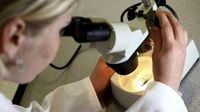On October 2, 2025, President Donald Trump made a high-profile pledge in Washington, D.C., promising $50 million to advance artificial intelligence (AI) research aimed at combating childhood cancer. This commitment, formalized through a new executive order, marks a significant moment in the ongoing battle against pediatric cancer—a disease that remains the leading cause of disease-related death among children in the United States, despite remarkable progress over the past several decades.
Trump, surrounded by children who have battled cancer, declared in the Oval Office, "We’re going to defeat childhood cancer once and for all." He added, "I’m thrilled to sign a very historic executive order to massively accelerate pediatric cancer research and harness the extraordinary potential of artificial intelligence to fight this terrible disease." According to CNN, Trump turned to the young patients beside him and assured them, "You’re all going to be better very soon." The moment was charged with hope, but also underscored by the stark realities facing families and researchers alike.
The executive order effectively doubles the U.S. National Institutes of Health’s (NIH) investment in a childhood cancer data initiative, which was originally launched during Trump’s first term. The additional $50 million will fund efforts to collect and analyze data from every child, adolescent, and young adult diagnosed with cancer nationwide, regardless of where they receive treatment. The initiative aims to help scientists unravel the complex nature of childhood cancers, a field that, as the Children’s Cancer Foundation points out, has historically received less than 10% of the federal cancer research budget.
Part of the new funding will support grants for scientists developing AI-driven solutions to pediatric cancer research. The White House has made it clear that integrating AI into the U.S. Department of Health and Human Services (HHS) systems is a priority. This integration is intended to enhance the sharing of health information among healthcare systems, organizations, and patients, with the goal of improving clinical trials, refining diagnoses, and tailoring treatments to be less harsh on young bodies.
Dr. Jay Bhattacharya, Director of the NIH, emphasized during Tuesday’s announcement that, "The treatments these little kids undergo involve therapies like chemo and radiation that put them through hell. Even though 85% will be cured, the therapies themselves can cause health problems if these kids age into adulthood. Nearly 60% of childhood cancer survivors experience severe life-threatening complications in adulthood." Bhattacharya credited the U.S. investment in research for vastly improved outcomes, but he also acknowledged the challenges posed by recent cuts to scientific funding.
Indeed, Trump’s announcement comes against a backdrop of significant controversy. According to CNN, the Trump administration has cut hundreds of millions of dollars from science research grants, including those supporting pediatric cancer research. The Pediatric Brain Tumor Consortium—a network that has provided children access to experimental treatments for 25 years—lost its federal funding in August 2025. The administration initially proposed slashing research initiatives at the National Cancer Institute by more than 37%, a move that alarmed many in the scientific and patient advocacy communities.
Mark Fleury, policy principal on emerging science and advocacy at the American Cancer Society Cancer Action Network, explained the stakes: "National Institutes of Health and the National Cancer Institute, they really fund important research that wouldn’t get funded otherwise. Oftentimes, this is basic research that is too far removed from a product that industry isn’t going to fund, but nonetheless industry sort of benefits from the research funding." Fleury cited Congressional Budget Office data, warning, "Even a 10% cut in NIH funding would result in 30 fewer drugs developed within 30 years and an average of two fewer per year after that. And that’s just the 10% cut."
Despite these funding battles, families affected by childhood cancer expressed cautious optimism at the executive order’s signing. Joshua Armstrong, whose daughter Laurel was diagnosed with leukemia at age two, told Trump, "Doctors are going to be able to get better treatments faster to patients like Laurel." For Armstrong and others, the promise of AI-fueled progress offers a glimmer of hope amid uncertainty about the future of research funding.
The Trump administration’s approach to AI in healthcare marks a sharp departure from the regulatory philosophy of the previous administration. In an op-ed published on October 2, 2025, Deputy Secretary of Health and Human Services Jim O’Neill and FDA Commissioner Dr. Marty Makary criticized what they described as the Biden administration’s decision to let the Coalition for Health AI (CHAI)—a nonprofit backed by major technology firms—set the rules for AI development in healthcare. According to O’Neill and Makary, "The Trump administration is choosing a radically different course, empowering us to unleash AI in a manner that better serves the public."
They argued that the Biden approach amounted to regulatory outsourcing, putting industry insiders in charge of rules that should be set by accountable public officials. "CHAI’s ties to the Biden administration render it incapable of impartial regulatory guidance," the officials wrote. Under the Trump administration, HHS Secretary Robert F. Kennedy Jr. has pledged that no nonprofit group, think tank, or company will be allowed to act as a government-backed AI regulator or policymaker. Instead, the administration says it will foster a "forward-leaning, pro-innovation, and pro-competition mindset" that encourages input from all stakeholders, including both large technology firms and startups.
This philosophy is already being put into action at the Food and Drug Administration. The FDA recently piloted an AI tool that enables scientific review tasks to be completed in minutes rather than days, and the agency managed to implement the tool agencywide by June 30, 2025—ahead of schedule and under budget. According to O’Neill and Makary, "FDA reviewers say that our AI tool enables them to complete certain scientific review tasks in minutes that used to take days. We know our scientists find the tool helpful because (1) they tell us, and (2) our internal analytics show that thousands of them use it each day."
The administration’s ambitions extend beyond cancer research. Officials say they plan to use AI to predict drug toxicity, reduce the need for animal testing, improve post-market safety monitoring, and enhance food inspections. The overarching goal, as articulated by O’Neill and Makary, is to "sustain and enhance America’s global AI dominance in order to promote human flourishing, economic competitiveness, and national security."
The debate over how best to regulate and fund AI in healthcare is far from settled. Critics argue that without robust oversight and sustained public investment, the promise of AI could be undermined by conflicts of interest and uneven access to new technologies. Supporters of the Trump administration’s approach counter that open, participatory processes and a pro-innovation mindset will ultimately yield better outcomes for patients.
As the administration moves forward with its AI cancer research initiative, the stakes could hardly be higher. For families like the Armstrongs, the hope is that this new investment will lead to better, safer, and more effective treatments for children facing cancer. For scientists and policymakers, the challenge lies in ensuring that the promise of AI is realized—not just in the lab, but in the lives of the children and families who need it most.





